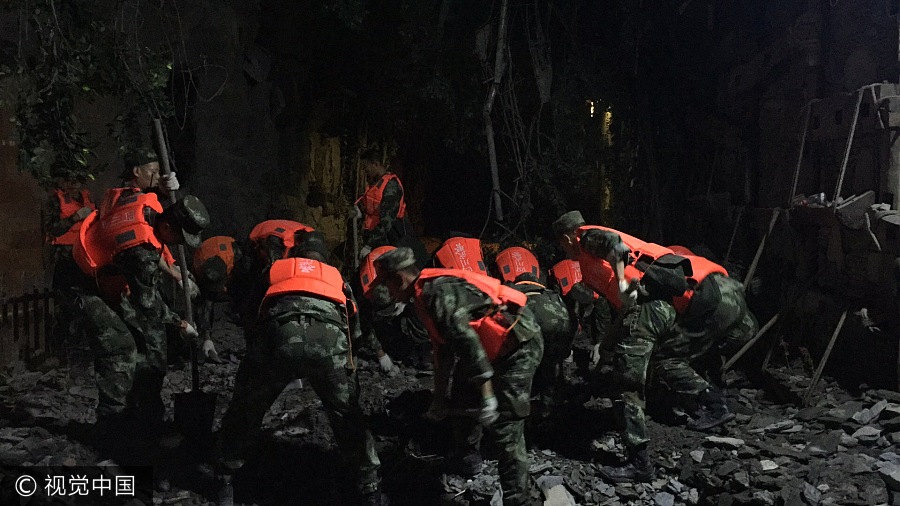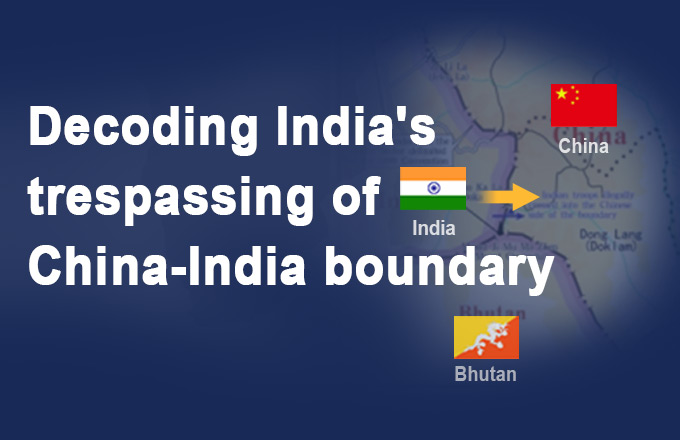Rescuers rush to Sichuan quake site
 |
|
Rescuers search through rubbles at the scenic spot of Jiuzhaigou county in Southwest China's Sichuan province on August 9, 2017, after a 7.0-magnitude quake hit the area on Monday night. More than 300 soldiers, nine vehicles, as well as 68 rescuers with search equipment have been sent to the quake site. [Photo/VCG] A 7.0-magnitude earthquake that hit Southwest China's Sichuan province on Tuesday has killed at least 13 people and injured 175, according to local emergency authorities. The epicenter was at a depth of 20 kilometers (12 miles), close to Jiuzhaigou county in the Aba Tibetan and Qiang autonomous prefecture. It was monitored at 33.2 degrees north latitude and 103.82 degrees east longitude, the China Earthquake Network Center said. Aftershocks measuring a magnitude of about 6.0, which had shaken the affected area over Tuesday night, may continue to strike places around the epicenter in the coming days, the center added. Jiuzhaigou national park, a popular tourist spot known for spectacular waterfalls and karst formations, is in the affected area and has been closed temporarily. President Xi Jinping has called for an all-out effort to rapidly organize relief work and rescue the injured, while evacuating and settling visitors. Because the earthquake took place during the flood period and tourism season, authorities should enhance meteorological early warning and geological monitoring to guard against other disasters and do their best to protect people's lives and property, Xi added. Premier Li Keqiang also urged local authorities to make every effort on relief and monitoring work. After the quake, the Earthquake Administration quickly launched emergency response system and dispatched officers to the affected area to handle emergencies. Meanwhile, the armed police force in Jiuzhaigou was ordered to reach the epicenter to keep order, according to the Armed Police Force's Sichuan Provincial Corps. More armed forces and doctors have been on their way and are expected to arrive at the epicenter around 11 am Wednesday. A hotline for tourists has been set up by the China National Tourism Administration, while provincial tourism authorities also have contacted travel agencies and hotels, collecting tourist information through instant messaging tools such as Wechat and QQ. Tourism departments around the county, such as Mianyang and Deyang cities in Sichuan, also have been asked to provide services for tourists. When the quake happened at 9:19 pm Tuesday, tremors were felt in the provincial capital Chengdu and as far away as Xi'an, Shaanxi province, according to local media. Yang Qihu, a bus driver in Chengdu, said she saw the lamp in her parlor shake as she had dinner with her 6-year-old son on Tuesday night. Although some in Chengdu, 285 km from the epicenter, felt the quake, Jiang Zuquan, a government worker in Ma'erkang, capital of the prefecture government, who happened to be in his office on the first floor, said he did not. "The epicenter is some 600 km from Ma'erkang and few colleagues felt it," he added. "The Jiuzhaigou earthquake is called a strike-slip earthquake, which often happens in China," said Jiang Haikun, a senior researcher at the China Earthquake Networks Center. Jiang said Sichuan is frequently struck by earthquakes in recent years due to the active Bayankala faulting block. "The 2008 Wenchuan Earthquake, 2013 Lushan Earthquake and 2010 Yushu Earthquake are all related to its movement," Jiang said. He warned that magnitude 6 aftershocks might hit the Jiuzhaigou area based on the overall movement of the Bayankala faulting block and the precedent of a large double-shock earthquake in the area. A heavy quake in Wenchuan, Sichuan, on May 12, 2008, killed almost 70,000 people. Zhao Lei contributed to this story. Contact the writers at caoyin@chinadaily.com.cn
|













